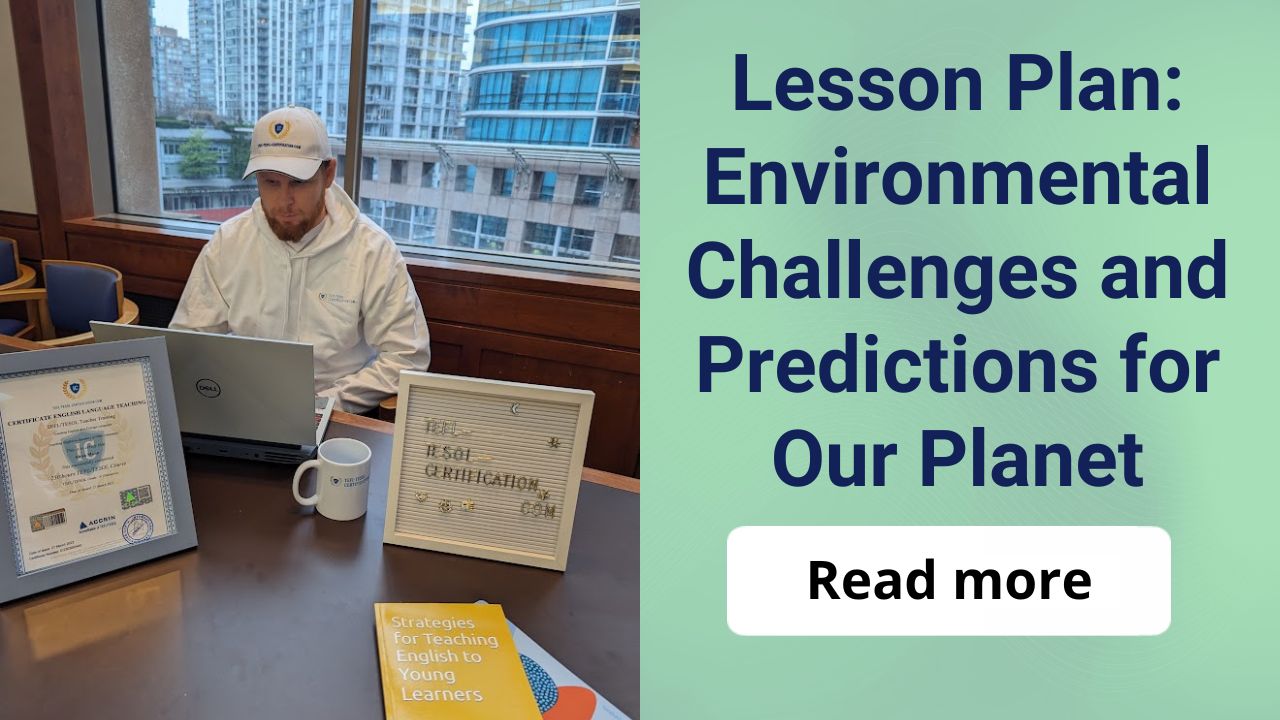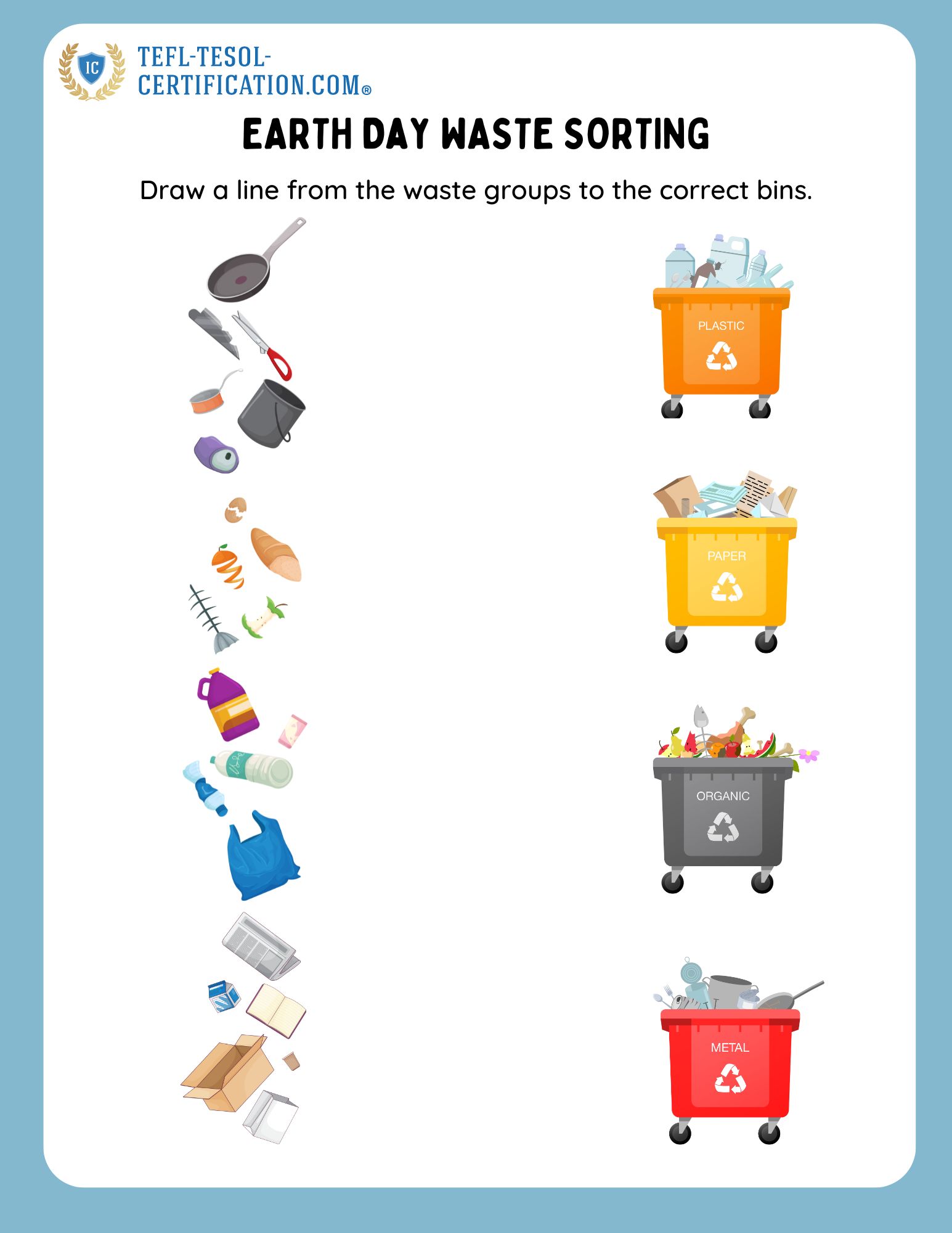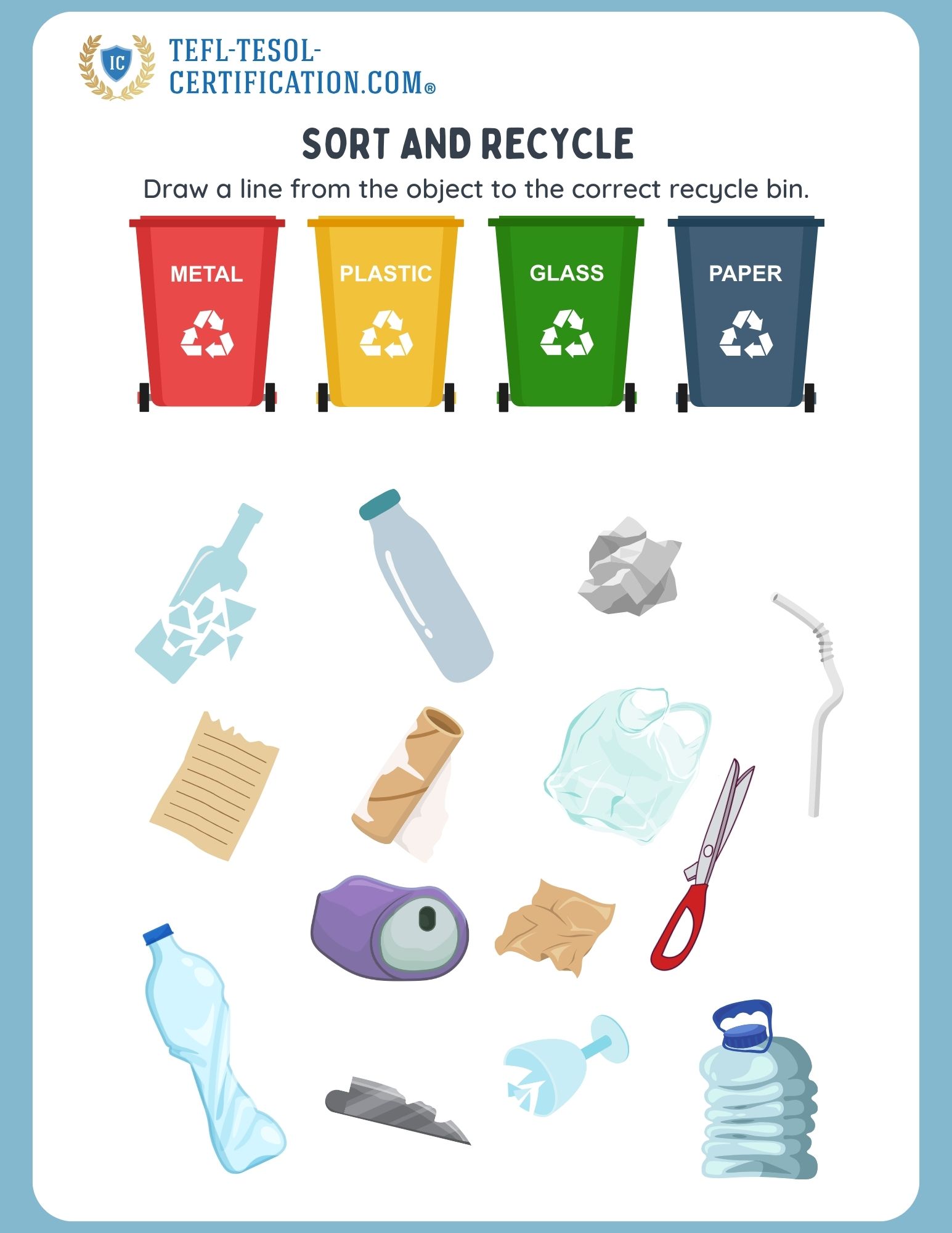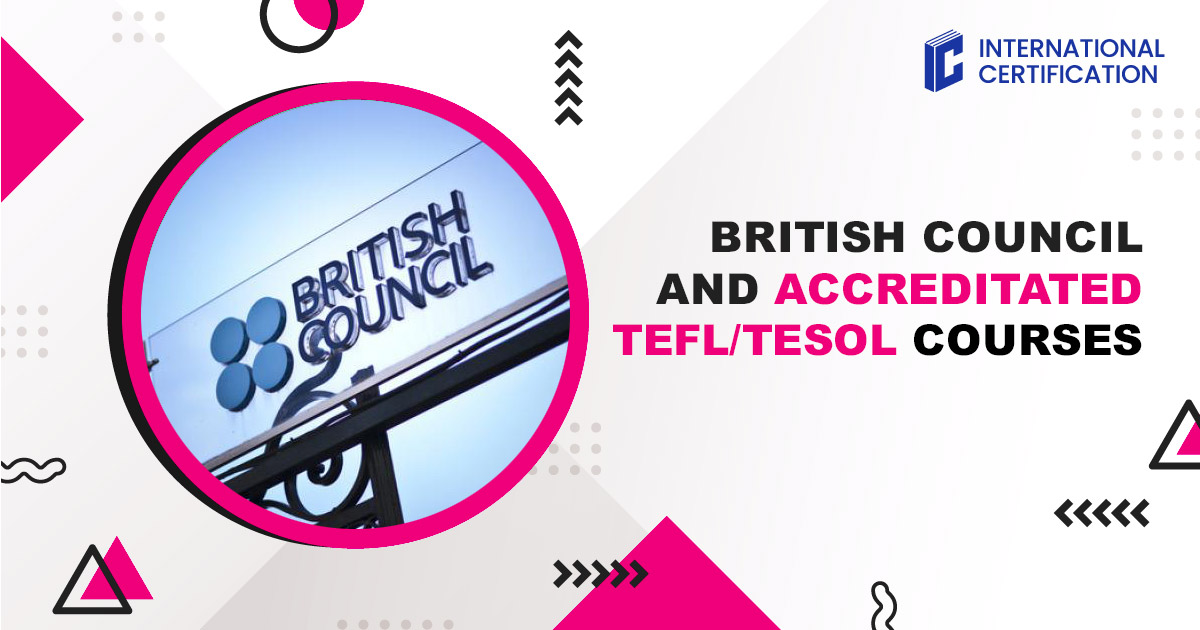And start earning money 💸 by teaching English in your own country, abroad, or online from anywhere on the planet! 🎁 Gifts and bonuses: professional support from your personal coach 🧑🏫 and job placement assistant 💼.

Lesson Plan: Environmental Challenges and Predictions for Our Planet
Table of contents
In crafting a lesson plan for English learners, maintaining a consistent structure ensures a smooth learning experience and aids in managing classroom time effectively. Each lesson, regardless of the specific topic or duration, follows a standardized format that incorporates key elements designed to enhance language acquisition and comprehension. Here’s an overview of the essential steps and elements that should be included in every lesson:
Standard Structure of Each Lesson
Warm-Up: This initial phase is designed to engage students from the start by activating their prior knowledge and setting the stage for new information. The warm-up might involve a quick discussion, brainstorming session, or a light activity related to the day's topic.
Setting the Objective of the Lesson: Experienced teachers often begin their lesson objectives with the phrase "By the end of the lesson, students will be able to..." followed by a communicative objective. For example, "to talk about their childhood/last weekend/ last summer holidays, using the Past Simple tense"; or "to discuss environmental issues and their impact on the planet, making predictions about the future, using the Future Simple tense."
Presentation Part: This is where a teacher takes center stage to explain or present new vocabulary, structures, or rules that align with the lesson's objectives.
Structured Activities: These could include tasks such as matching words with their definitions to work with vocabulary, reading to identify a new grammar structure in the text, or engaging in other games that are, of course, aligned with the lesson's objective.
Semi-Structured Activities: You might offer students the opportunity to watch a short video and then answer prepared questions to check their understanding. This stage helps students prepare to work independently and use new language chunks or structures fluently.
Unstructured Activity: This is the goal your students have been working towards—practicing their speaking skills to communicate in English. The best approach is to organize the class into pairs, allowing each student maximum speaking time. Give them a topic to discuss that relates to the lesson's objective. Your task as a teacher is to monitor the process and make notes about the most common mistakes. This will help you understand what needs to be revised.
Evaluation: This stage of a lesson is crucial for assessing both student progress and the effectiveness of the teaching strategies used. It helps educators determine whether the learning objectives have been met and what adjustments might be needed for future lessons.
Homework: Conclude the lesson by summarizing the day's learning and assigning homework to reinforce the topics covered. For practicing writing skills, assigning homework is an effective method. Students have enough time to think while writing, and teachers can preserve valuable class time for other tasks.
The amount of content covered and the depth of each segment may vary based on the allotted time and specific learning objectives. However, the structure remains consistent, providing a familiar and effective framework for each class session. This predictable pattern helps students feel more secure and engaged, knowing what to expect and how to prepare for each phase of the lesson. Adjustments can be made to accommodate specific needs or interests, but the overall structure provides a reliable blueprint for effective learning.
This lesson plan "Forecasting the Future: Exploring Environmental Challenges and Predictions for Our Planet" follows the standard structure and is designed for English learners focused on environmental topics and future predictions, providing both an engaging and educational experience. It includes a variety of activities to build language skills while discussing important environmental issues. Here's a suggested outline:
Warm-up
Begin with a brief brainstorming discussion to engage students and introduce the topic. Potential questions include:
"How does sorting trash help the environment?"
"Why should I sort my waste?"
"Do you sort your waste? Why or why not?"
"When is Earth Day?"
This discussion helps students dive into the topic and warms them up at the beginning of the lesson.
Objective
The objective could be: 'By the end of the lesson, students will be able to discuss environmental issues and their impact on the planet, making predictions about the future, using the Future Simple tense.’
Presentation Stage
This stage depends on what your students already know. Consider if they are familiar with the Future Simple tense to make predictions. It's beneficial to present related vocabulary, which should be tailored to the age and Prociency level of your students.
Here is a list for you to choose the most appropriate terms:
- Biodiversity
- Conservation
- Ecosystem
- Sustainability
- Renewable Energy
- Greenhouse Gases
- Climate Change
- Deforestation
- Pollution
- Habitat Loss
- Carbon Footprint
- Ozone Depletion
- Recycle
- Biodegradable
- Fossil Fuels
- Global Warming
- Overpopulation
- Renewable Resources
- Acid Rain
- Eco-Friendly
- Extinction
- Environmental Impact
- Organic
- Natural Resources
- Wildlife Conservation
- Soil Erosion
- Environmental Activism
- Sustainable Development
- Non-Renewable Resources
- Conservationist
Structured Activity
You can create a task using these words for the Structured Activity Stage, such as matching a word with its definition or a fill-in-the-blanks task. Here are some possible examples I have prepared for you:






If your students have a lower level of English Prociency, you can use worksheets with fewer vocabulary terms while still facilitating discussion. Include basic terms such as sort, recycle, recycle bin, waste, plastic, glass, paper, metal, environment, eco-friendly, reusable, and conserve, among others.


Semi-Structured Activity
The Semi-Structured Activity should be a bit more challenging than the previous one. It offers a great opportunity to practice listening skills by letting students watch a short topic-related video. This allows them to grasp the language in context. You can select any video or audio you prefer.
Before watching the video, distribute a worksheet with questions based on the video's content. Give students a minute to review the questions and inform them that you expect them to answer all of these questions after watching the video. The questions should be designed so that students need to explain both the general gist of the video and some specific details. If necessary, play the video two to three times. Consider organizing students into groups, teams, or pairs, allowing them to discuss the questions and their answers collaboratively, as this interaction is always beneficial for learning.
- What is the main focus of the video?
- What does the video primarily discuss regarding plastic pollution?
- Why is plastic pollution considered a significant environmental issue?
- What reasons does the video give for why plastic pollution is harmful?
- What are the primary sources of plastic pollution mentioned in the video?
- Where does most of the plastic pollution come from, according to the video?
- How does plastic affect marine life?
- What impact does plastic pollution have on ocean ecosystems and marine organisms?
- What statistics are provided about plastic production and waste?
- What figures does the video share about the scale of plastic production and waste generation?
- What are microplastics, and why are they a concern?
- How does the video explain the problem of microplastics and their environmental impact?
- How can individuals reduce their plastic footprint?
- What suggestions does the video offer for people looking to reduce their plastic usage?
- What role do governments and corporations have in addressing plastic pollution?
- According to the video, what responsibilities do larger entities have in tackling plastic pollution?
- Are there any innovative solutions presented for tackling plastic pollution?
- What new ideas or technologies does the video discuss that could help mitigate plastic pollution?
- What is the overall message of the video about the future of plastic pollution?
- When did Rwanda implement its ban on plastic bags?
- Name the five Asian countries that are the top contributors to marine life pollution according to the video.
Unstructured Activity
The next stage is the Unstructured Activity, which serves as the culmination where students have the opportunity to apply all the new vocabulary and structures and practice fluent speaking. Given that numerous environmental issues have been discussed during the lesson, it's now time to make some predictions about the future. Encourage students to use the Future Simple tense, as this aligns with the lesson’s objective. If your objective was different, for example, focusing on modal verbs such as may, might, must, can, could, and would, then you should tailor the questions accordingly and encourage students to use these verbs in their responses. To maximize each student's speaking time, the best approach is to have them work in pairs.
Here are some discussion questions designed to help students practice using the Future Simple tense, with a focus on environmental issues and making future predictions:
- Will governments ban single-use plastics worldwide in the next decade?
Encourage students to predict and explain their reasoning.
- How will climate change affect your country in the next 20 years?
Ask students to make specific predictions based on their knowledge of local environmental issues.
- What will be the most significant technological advancement in renewable energy?
Have students speculate about future innovations in the field of renewable energy.
- Will more species become extinct in the next 50 years than in the last 50 years?
Discuss the factors that might influence these outcomes.
- How will urban areas change to accommodate growing populations and environmental challenges?
Students can predict changes in infrastructure, green spaces, and city planning.
- Will people change their eating habits due to environmental concerns?
Explore whether individuals might shift towards more sustainable diets.
- Will the use of electric vehicles replace gasoline and diesel cars in your city?
Encourage predictions about the future of transportation in their own areas.
- Will schools around the world incorporate more environmental education in their curricula?
Discuss the importance and potential impact of environmental education on future generations.
Evaluation
The Evaluation stage should be brief. For example, you could read sentences aloud and ask students to vote with their thumbs up for true sentences and thumbs down for false ones. This method allows you to quickly check their understanding.
True Statements:
- Climate change is primarily caused by human activities such as burning fossil fuels and deforestation.
- Recycling helps reduce waste in landfills and conserves natural resources.
- The Amazon Rainforest is often referred to as the "lungs of the Earth" because it produces about 20% of the world's oxygen.
- Solar and wind energy are renewable resources that produce little to no greenhouse gases.
- The Great Pacific Garbage Patch is a large area in the Pacific Ocean filled with floating plastic debris.
False Statements:
- Global temperatures have been steady over the past century.
- Planting trees has no impact on carbon dioxide levels in the atmosphere.
- All types of plastic are biodegradable and pose no long-term risks to wildlife.
- The majority of the Earth's fresh water is readily available for human use.
- Air pollution is only a problem in developing countries.
These statements can help students apply their knowledge of environmental issues and practice distinguishing between factual and inaccurate information.
💡 Unlock the secrets to doubling your teaching income with our exclusive checklist! 🎯 This checklist is designed for English teachers who want to 📈 attract more students and 🔥 keep them engaged for the long term.
Homework
For homework, ask the students to conduct research and write an essay on one of the chosen topics. Here are several suggestions:
"The Impact of Fast Fashion on the Environment: Challenges and Solutions"
Explore the environmental consequences of the fast fashion industry and discuss potential sustainable practices that could mitigate its impact.
"Renewable Energy and Its Role in Global Energy Security"
Analyze how renewable energy sources could enhance global energy security and reduce dependence on fossil fuels.
"Urban Sprawl and Its Effects on Biodiversity"
Discuss how urban sprawl affects local wildlife and biodiversity, and propose urban planning strategies to minimize environmental disruption.
"The Ethics of Genetic Modification: Potential Benefits and Risks for Biodiversity"
Examine the ethical considerations of using genetic modification in agriculture and its potential impacts on biodiversity.
"Plastic Pollution in Oceans: Causes, Consequences, and Cleanup Efforts"
Investigate the sources of plastic pollution in the oceans, its effects on marine life, and review the efforts being made to clean and reduce this pollution.
These topics encourage students to engage deeply with current environmental issues, requiring them to research, analyze, and propose solutions based on their findings.
Get TEFL & TESOL Certified.
Using a structured lesson plan is crucial for effectively teaching English to learners of different ages. It ensures that each lesson is organized and progressive, helping students build on their skills systematically. Modern teaching methods, which can be learned in TEFL/TESOL courses, are essential as they incorporate various strategies tailored to diverse learning styles and age groups. Such courses are indispensable for EFL/ESL teachers, as they provide the necessary tools and methodologies to enhance teaching effectiveness and meet the educational needs of all students.
Terms used:
EFL, ESL

York Fern
An English instructor with 12+ years of experience. I work for an online school and travel the world, teaching students from various countries, leveraging my TEFL/TESOL certification. Seeing the world's oceans, mountains, and cities with my own eyes has given me a profound appreciation for the importance of quality education and international communication.
and start earning by teaching English in your country, abroad, or online from anywhere in the world! Order the course with a 50% discount 💸 and receive as a gift the support of a personal coach 👨🏫 and job placement assistant! 🎁🚀 Hurry, limited spots available! 🏃♂️💨
💡 Unlock the secrets to doubling your teaching income with our exclusive checklist! 🎯 This checklist is designed for English teachers who want to 📈 attract more students and 🔥 keep them engaged for the long term.
🚀 More students, 💰 higher income, 🌍 complete freedom! ✅ 112 verified platforms with top rates ⏳ Flexible schedule – work whenever and as much as you want 🎯 Simple requirements – start earning right away 💎 Boost your career and income by teaching students worldwide!
choose us?



